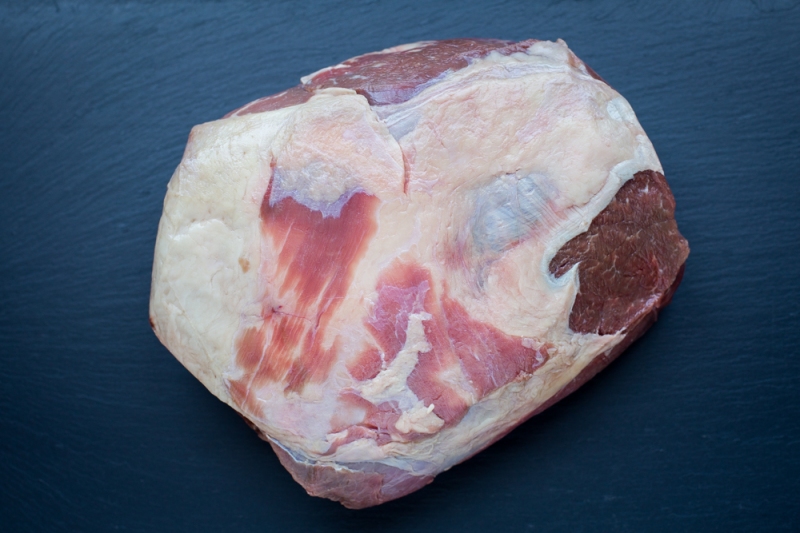
My friends at US Wellness Meats recently sent me a cut of beef I’d never seen before. The heart of shoulder roast, sometimes called the heart of clod or cross-rib roast, is a center cut roast taken from the shoulder, similar to chuck roast. Typically I would oven-braise a shoulder roast in order to break down its connective tissue. But heating an oven for several hours doesn’t sound like a good time to me right now considering that we’re in the heat of summer; so I did what any sensible American would do with a big chunk of meat in July – I barbecued it.
This recipe is not unlike the Barbecue Brisket recipe in my book, just cooked at a slightly lower temperature; the lower temperature drags the cooking process out a bit, but results in a more evenly tender roast. Feel free to use this recipe for brisket as well.

Barbecue Heart of Shoulder Roast
5-6 lb heart of shoulder roast (or brisket)
~1/3 cup Sugar-Free Barbecue Rub (see note below)
1 handful wood chunks (hickory or pecan preferred)
1 handful wood chips (hickory or pecan preferred)
1 cup beef broth
1. Rub the shoulder roast all over with the barbecue rub, then cover tightly with two layers of plastic wrap. Refrigerate overnight.
2. Set up your grill for indirect smoking. If using a charcoal grill, bank the charcoal to one side and add some wood chunks to the charcoal. On the other side of the grill, place a large aluminum pan filled with about 1″ of water. If using a gas grill, place two small aluminum pans on one side of the grill; put wood chunks in one pan, and wood chips in the other. Fill the pan with wood chips up with about 1″ of water. This will allow the wood chunks to smoke first, then the water will evaporate from the other pan and the chips will smoke next. On the other side of the gas grill, place a large aluminum pan and fill it with about 1″ of water. See the illustrations and picture below for a better look at the setup. This is my standard setup for most barbecuing and smoking endeavors.
3. Light your grill and bring the temperature on the cool side of the grill to about 250F (plus or minus 25 degrees is okay). If using a gas grill, only light the burners that are underneath the small pans.
4. Remove and discard the plastic wrap from the roast, then place the roast on the cool side of the grill (over the large aluminum pan). Place it fatty-side-up, with the thickest part of the roast facing the hot side of the grill. Cover the grill and smoke until the roast registers an internal temperature of 160F, about 2-3 hours. If using a charcoal grill, replace charcoal and wood chunks as needed.
5. Wrap the roast with heavy duty tinfoil, and pour 1 cup of beef broth in with the roast before completely wrapping it. Return to the grill and barbecue until the roast can be pierced with a toothpick with little resistance or reaches an internal temperature of 200F, about 1-2 more hours. Once finished, let cool for 20 minutes before unwrapping and slicing. Serve with the liquid inside the tinfoil. Mix the liquid with some barbecue sauce for even more flavor.
** While you could use an quick-read thermometer to check your roast, opening the grill lid repeatedly to check will mess with the grill’s internal temperature. I use a remote grill thermometer, which allows me to monitor both the grill and meat temperatures without lifting the lid. It’s very easy to set up, and it’s a gadget, which is a win in my book (I’m a fan of all things gadget).
** My barbecue rub recipe yields more rub than you’ll need for this recipe, but we’ve found that it’s always good to make extra rub for those days that you want barbecue but don’t want to make a rub right then and there. We store ours in a sealed mason jar.
** You don’t necessary have to refrigerate the seasoned roast overnight, but it makes for a tastier end product. If you don’t have the time, simply refrigerating the roast for 30 minutes will improve the flavor as well.
** For a more tender roast, place the finished roast (still in tinfoil) in a small container (a cooler or an unused microwave) for 1 hour to let it cool.
** I suggest only slicing as much roast as you’re going to immediately eat, since exposing barbecued beef to air will dry it out quickly.

illustrations by Alex Boake

Here’s my typical gas grill setup, with the back burner lit and the other two off (my grill has three burners that run horizontally).

Anything BBQ is always a good idea! Can’t wait to try this!
LikeLike
Been wanting to try beef clod for a while. Might have to fire one up this weekend. I think I might inject first though to add a little more flavor to the interior.
LikeLike
Mmmm. Might just have to do some iteration of this for the 4th. Our new smoker attachment has gotten me a little smoke crazy. :)
LikeLike
I cannot wait to try this! Too often we just end up putting regular steak on the grill when we use it, and I’m always excited to find other ideas!
LikeLike
Great beat ! I wish to apprentice at the same time as you amend your site,
how can i subscribe for a blog web site? The account
helped me a applicable deal. I have been tiny bit acquainted of this your broadcast provided bright clear idea
LikeLike
Sounds like this would be very good for corning and smoking for pastrami
LikeLike